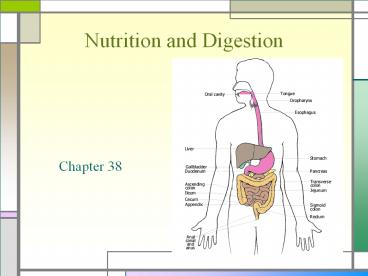Nutrition and Digestion - PowerPoint PPT Presentation
1 / 21
Title:
Nutrition and Digestion
Description:
Nutrition and Digestion Chapter 38 ... – PowerPoint PPT presentation
Number of Views:276
Avg rating:3.0/5.0
Title: Nutrition and Digestion
1
Nutrition and Digestion
- Chapter 38
2
Nutrition-
- The process by which organisms get food and break
it down for metabolism
3
6 Essential Nutrients
- Proteins (organic)
- Carbohydrates (organic)
- Fats (organic)
- Vitamins (organic)
- Minerals (inorganic)
- Water (inorganic)
4
Remember
- Autotrophs-
- organisms capable of making their own food
- Heterotrophs-
- organisms that must obtain food from their
environment
5
The Human Digestive System
- Also called the alimentary canal or the
gastrointestinal tract
6
Diagram of Human Digestive System
1.
2.
4.
3.
5.
6.
7.
8.
9.
10.
11.
7
Digestive system organs
- The alimentary canal (digestive tract) of the
human is made up of the following ordered
sequence. Food passes through these structures - -oral cavity or mouth
- -pharynx
- -esophagus
- -stomach
- -small intestine
- -large intestine
8
Accessory organs
- Other organs/glands are important for disgestion.
Food does not pass through these structures - -gall bladder
- -liver
- -pancreas
- -appendix
9
Functions of all organs and structures in the
human digestive system
10
I. Oral cavity or mouth
2.
- Lining of the mouth is epithelial tissue
- Secretes mucous (protection)
- Stimulation of taste buds results in secretion of
saliva - This starts chemical digestion
- Carbohydrate digestion begins in the mouth
(amylase) - Teeth begun mechanical digestion
1.
3.
4.
- Salty
- Sweet
- Sour
- Bitter
11
II. Pharynx
- Food passes through this narrow region and goes
into the esophagus.
12
III. Esophagus
- Tube that connects the pharynx to stomach.
- Food enters by wavelike motion of smooth muscle
contractions called peristalsis.
13
IV. Stomach
- sac like
- contains gastric juice
- This is water, hydrochloric acid, mucus, and the
enzyme pepsin. - Protein digestion begins here.
- Bacteria are destroyed by acid environment
- Peristalsis is occurring here.
- Ulcers may develop here.
14
V. Small intestine
- About 20-25 feet long
- Contains folds or villi that increase the surface
area
Villi___________
15
Small intestine cont
- Most absorption of nutrients into the blood
stream occurs here. - Most chemical digestion is occurring here.
- Lipid digestion occurs here.
- Peristalsis is continuing.
- The small intestine receives secretions from the
liver and pancreas.
16
VI. Large intestine (colon)
- Water absorption
- Feces formation
- Appendix located at end of large intestine
- This is a vestigial organ-it no longer has a
useful function.
17
VII. Liver
- Largest organ
- Functions
- Secretes bile
- Produces urea
- Breakdown of worn out red blood cells
- Breakdown of proteins into amino acids
- Removes sugar from blood
- Stores sugar as glycogen
18
Liver cont
- Excessive use of alcohol and some drugs can cause
damage to the liver - Bile produced by liver is stored in gallbladder.
- Function is to break up lipids
- Therefore people without a gallbladder must watch
their fat intake.
19
VIII. Pancreas
- Functions
- Hormone secretion. (hormone-chemical in blood
for regulation) - Secretes enzymes into small intestine for
digestion. - Regulates blood sugar levels.
- Cells inside pancreas called the Islets of
Langerhans - Secretes glucagon when blood sugar is too low
- Secretes insulin when blood sugar levels are too
high
20
(No Transcript)
21
Malfunctions of the Digestive Tract
- Ulcers-erosion of the lining in the stomach
- Constipation-large intestine emptied with
difficulty. Caused by too much water absorption
in large intestine - Diarrhea-disturbance characterized by decreased
water absorption and watery feces. May result in
severe dehydration. - Appendicitis-inflammation of appendix
- Gall stones-accumulation of cholesterol in gall
bladder































